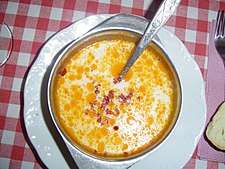Tripe chorba
Tripe chorba (Turkish: işkembe çorbası, Bulgarian: шкембе чорба, romanized: škembe čorba) is a chorba (soup) made with tripe (cow stomach). It is widely (not universally) considered to be a hangover remedy.[1][2]
.jpg) | |
| Type | Tripe soup |
|---|---|
| Place of origin | Turkey |
| Associated national cuisine | |
Etymology
The Turkish name işkembe çorbası, meaning "tripe soup", consists of işkembe ("stomach/tripe"), çorba ("soup"), and the possessive affix -i that links the two words. It came from Persian shekambe (شکمبه, "rumen") and shurba (شوربا, "soup") came from Persian.[3] Some South Slavic languages borrowed the dish name from Turkish: as škembe čorba (шкембе чорба) in Bulgarian and Macedonian, and as škembić (шкембић) in Serbian and Bosnian.
Variants
Turkey
.jpg)
In Turkey, tripe chorba is generally made of cow's stomach and eaten usually with a vinegar-garlic sauce added on the table or with the addition of an egg yolk-lemon juice (called terbiye) in the kitchen, after cooking and before service. Although the general name işkembe çorbası is very common, especially at the traditional restaurants dedicated to this soup, offal of cow and sheep and kelle (sheep head meat, especially cheeks, baked) are also offered. A dish can be ordered and made from the various parts of the stomach: "Tuzlama, işkembe, şirden and damar". As in several other countries, it is seen as a "hangover remedy" and finds itself a place in almost all New Year's Eve menus, served right after midnight. This has been the case since the 1800s, when it was first reported as a popular soup among Ottomans to consume immediately after a session of heavy social drinking, usually of rakı.[4]
Bulgaria

In Bulgaria, a whole pork, beef or lamb tripe is boiled for few hours, chopped in small pieces, and returned to the broth. The soup is spiced with ground red paprika which is briefly fried (запръжка), and often small quantity of milk is added. Traditionally, the soup is served with mashed garlic in vinegar and hot red pepper. There is a variant of the soup with intestines instead of tripe.[5]
The soup was very popular with the working classes until the late 1980s, and there were many restaurants serving only shkembe chorba (шкембеджийница, "shkembe-restaurant"). Later they were replaced by fast food restaurants but the soup is still highly regarded, and is part of the menu in any cheap to moderately-priced restaurant. Office workers avoid eating shkembe chorba at lunch, or eat it without adding garlic.
Romania

The Romanian name for the sour tripe soup is ciorbă de burtă (from ciorbă 'sour soup' < Turkish çorba + burtă 'tripe'). The Romanian ciorbă de burtă is similar to ciorbă de ciocănele (soup from pork legs). Ciorbă de burtă is often seasoned with vinegar, sour cream (smântână) and garlic dip (crushed garlic mixed with oil), called mujdei. The Romanian journalist Radu Anton Roman said this about Ciorbă de burtă: "This dish looks like it is made for drunk coachmen but it has the most sophisticated and pretentious mode of preparation in all Romanian cuisine. It’s sour and sweet, hot and velvety, fatty but delicate, eclectic and simple at the same time.[6]"
Serbia
In Serbia, this soup is made of fresh tripe cooked with onions, garlic and paprika. It is usually seasoned with fried bacon and more garlic, sometimes thickened with flour (запршка). Some versions of shkembe chorba are made with milk; garlic, vinegar, and chili peppers are often added as seasoning.
Similar dishes
A similar dish made with trotters, called pache or pacha (Albanian: paçe, Bosnian: pače, Bulgarian: пача, romanized: pača, Greek: πατσάς, romanized: patsas, Turkish: kelle paça) is found in the Turkish, Greek, Balkan, and East European cuisines.
References
- Annie Kay, Bulgaria, Bradt Travel Guides, 2015, p. 57
- DK Eyewitness Travel Guide: Istanbul, 2014, p. 199
- "çorba - Kelime Etimolojisi, Kelimesinin Kökeni". www.etimolojiturkce.com. Retrieved 2019-12-01.
- çorba. ISBN 978-1-86064-698-0.
- Albala, K. (2011). Food Cultures of the World Encyclopedia. Food Cultures of the World Encyclopedia. Greenwood. p. 3–PA67. ISBN 978-0-313-37626-9. Retrieved 21 November 2018.
- Des poissons sur le sable by Radu Anton Roman, Éditions Noir sur Blanc, publié en 1997